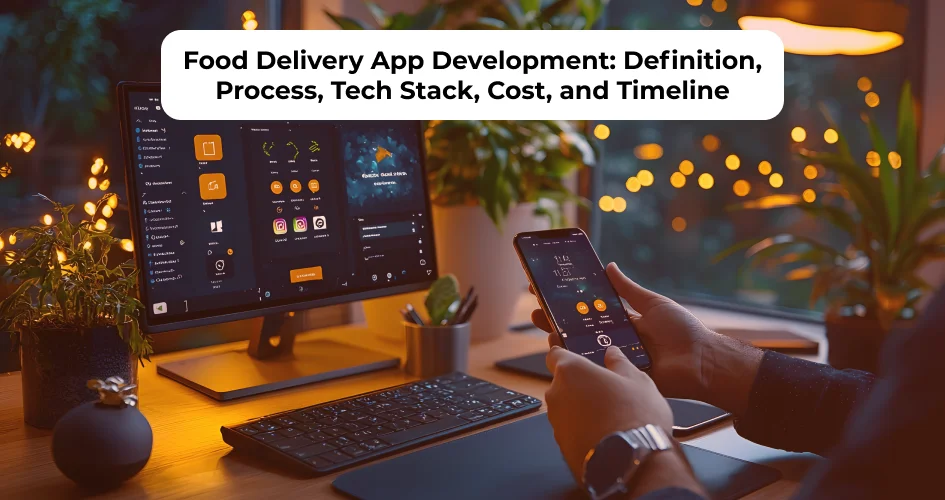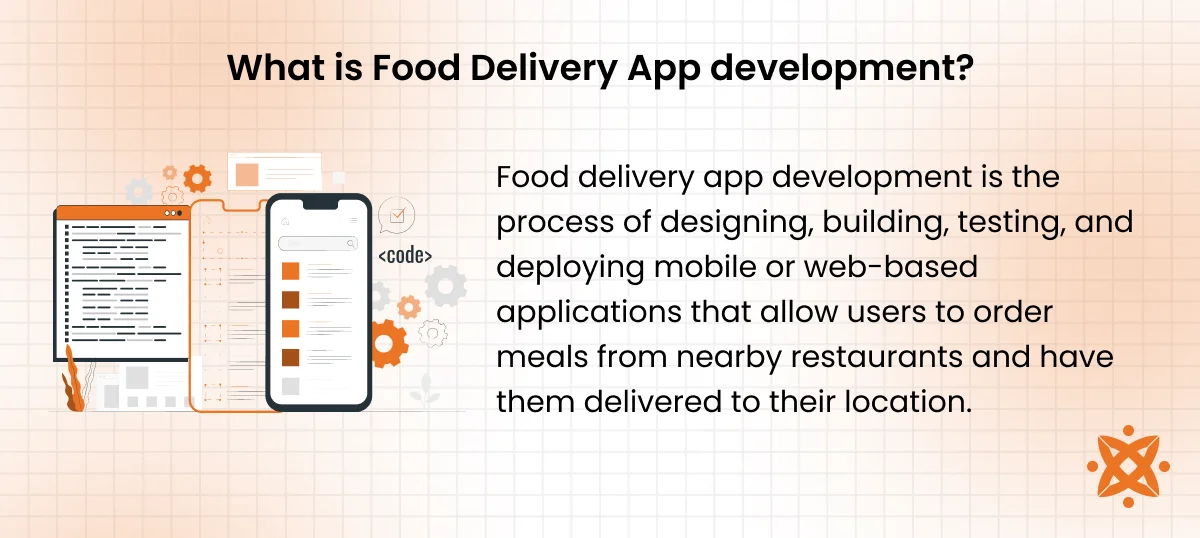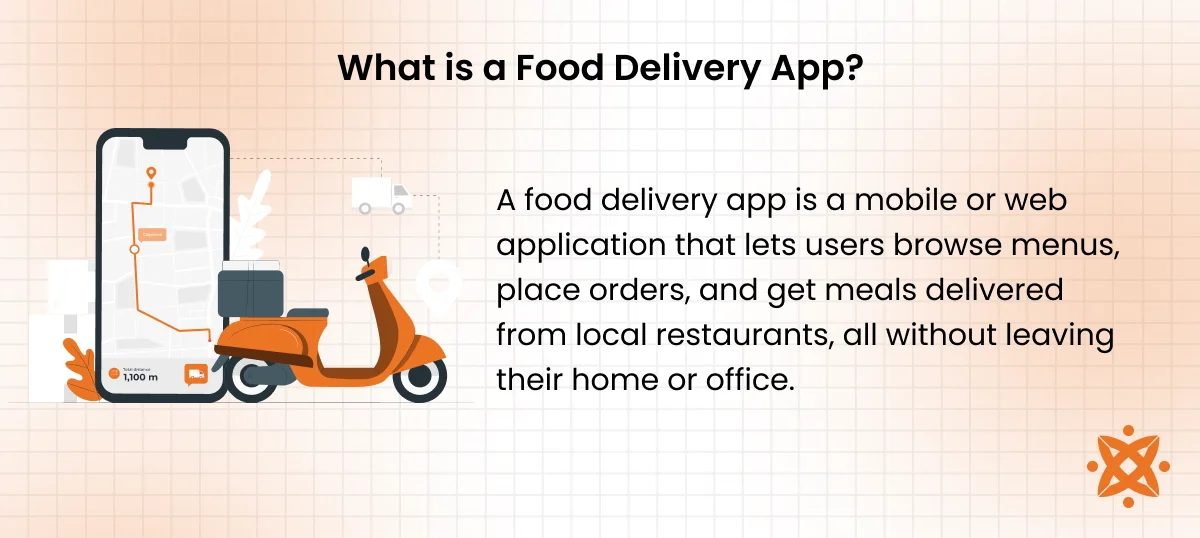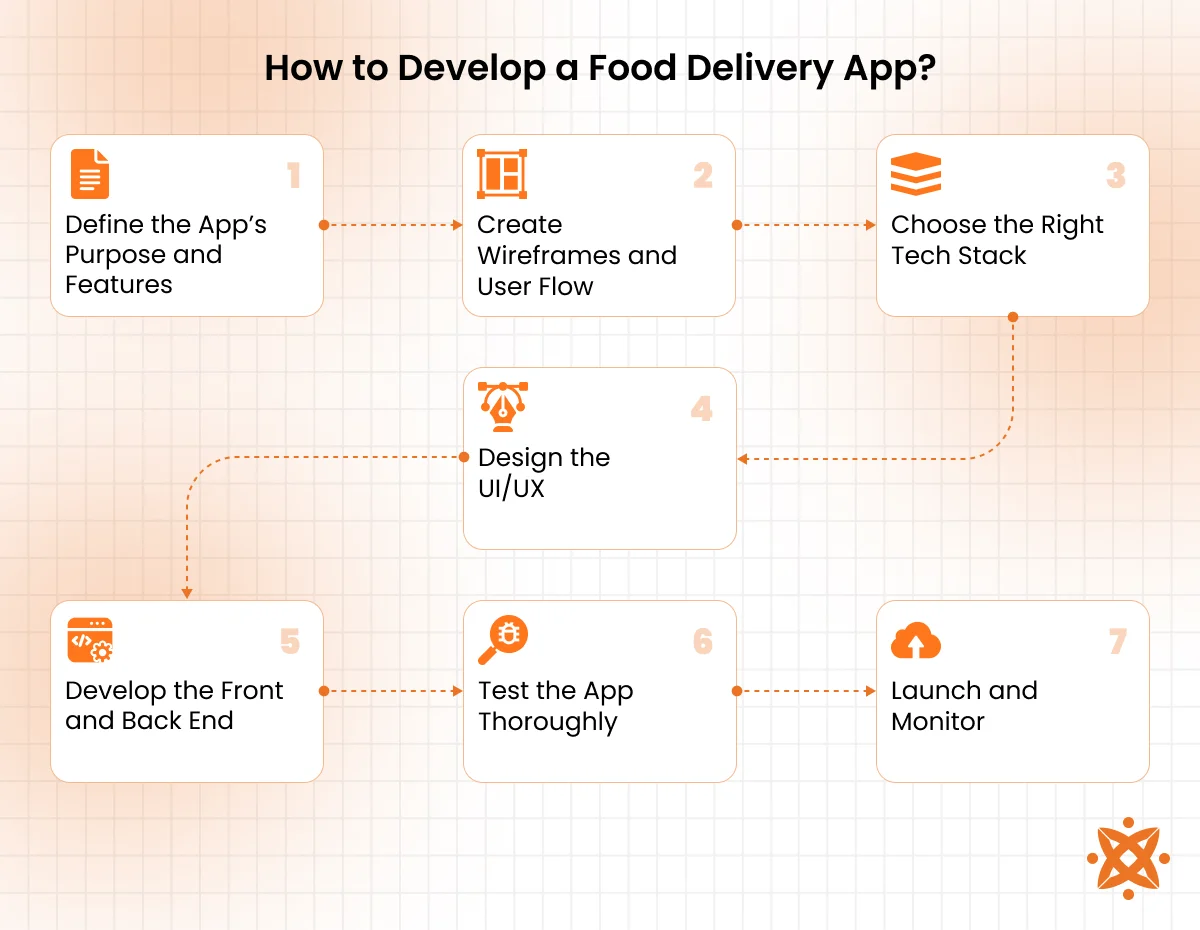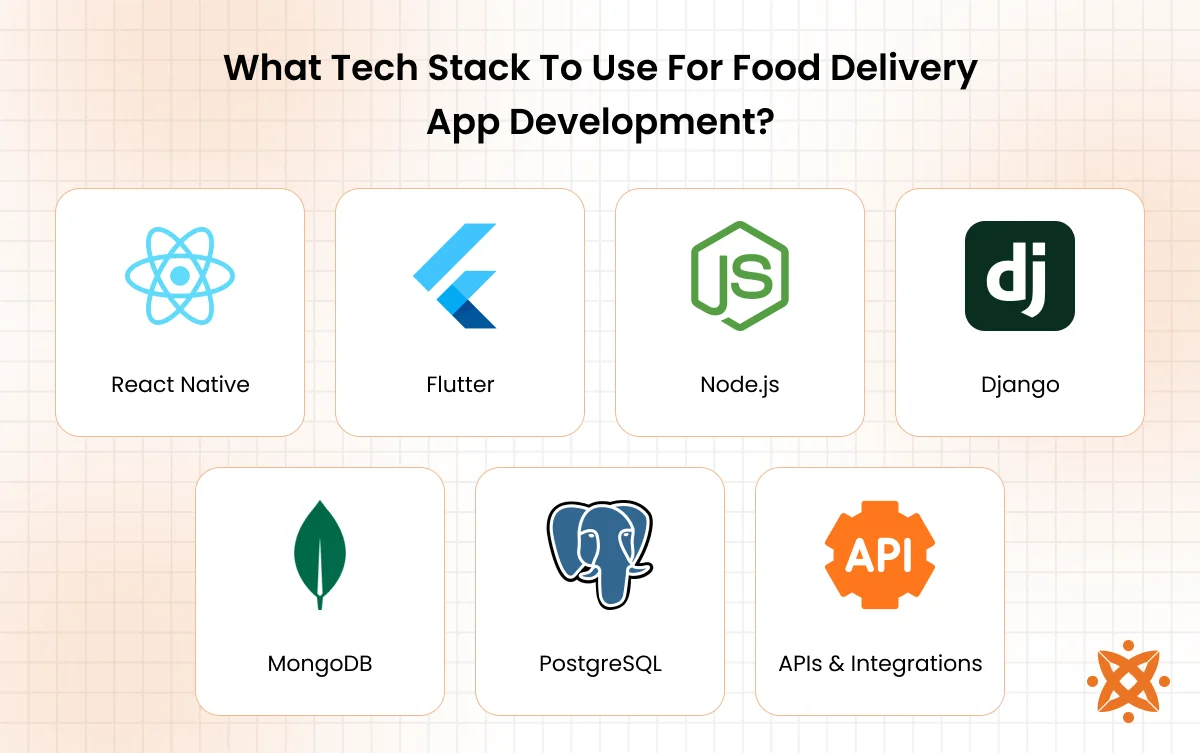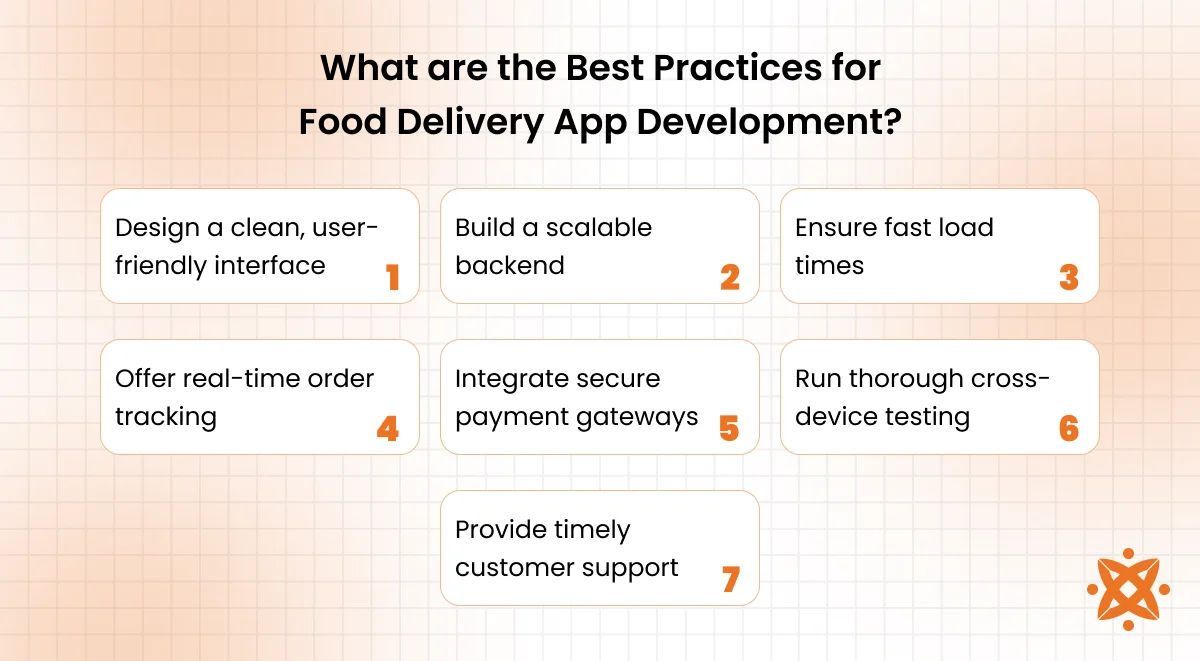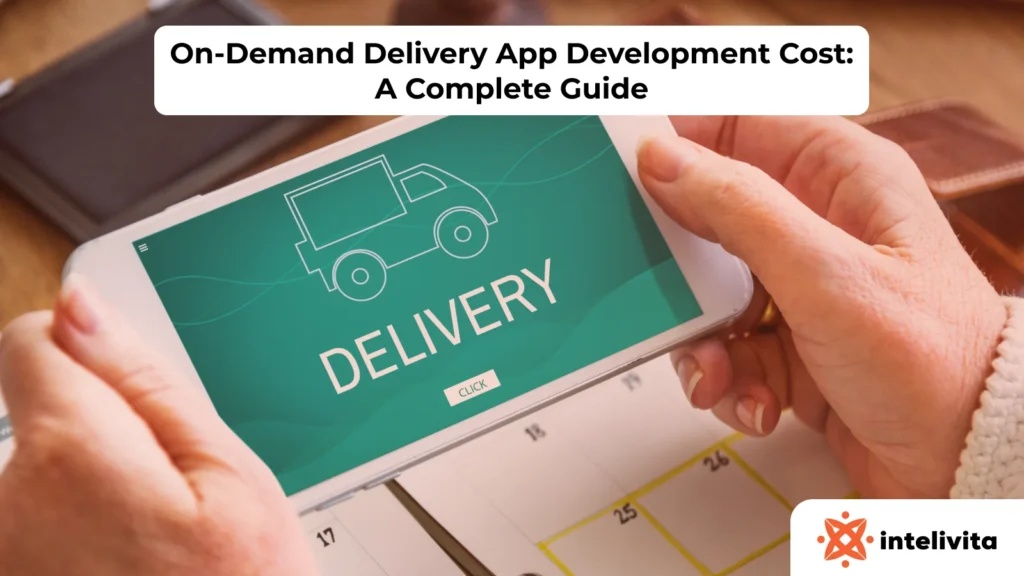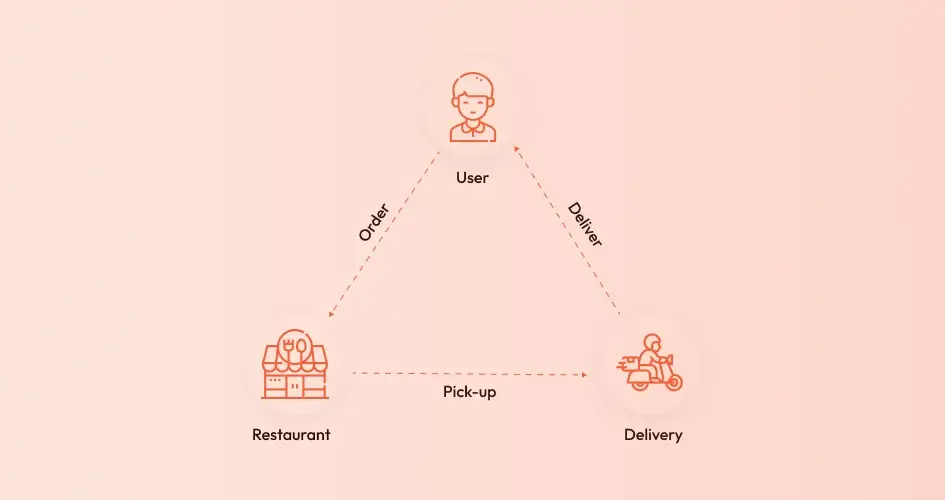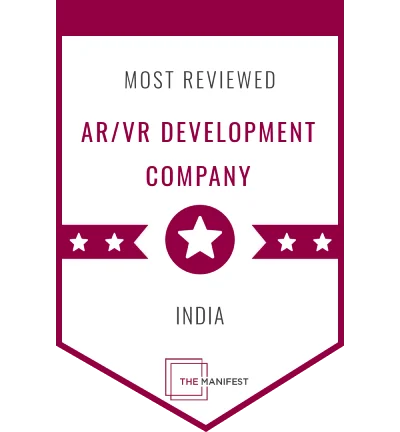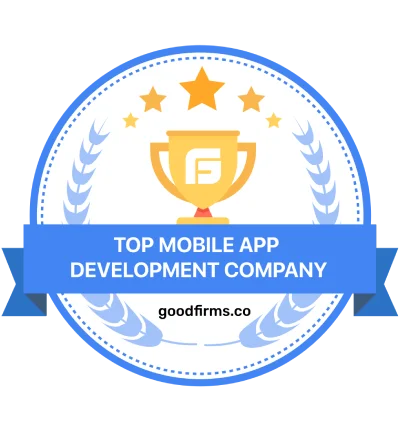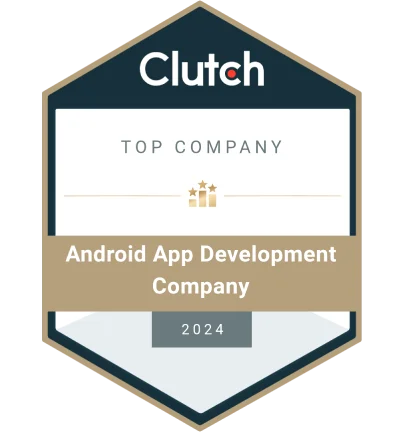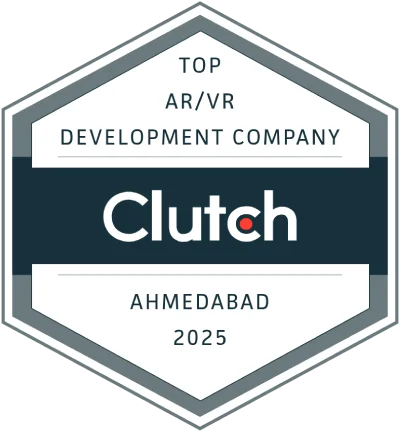Food delivery app development refers to creating digital platforms that allow users to order food from nearby restaurants and have it delivered to their door. It combines front-end design, back-end infrastructure, real-time tracking, payment systems, and third-party integrations into one smooth experience.
The food delivery app development tech stack includes Flutter or React Native, Node.js or Django, and MongoDB or PostgreSQL. Additional integrations include Google Maps API for location tracking, Stripe or PayPal for payments, and Firebase for notifications and user analytics.
To build a food delivery app, you start with market research and feature planning, followed by wireframing and UI/UX design. After choosing the right tech stack, developers build both the customer and admin panels, integrate APIs, conduct rigorous testing, and then launch on app stores.
A food delivery app costs between $10,000 and $50,000 depending on features, tech stack, development region (U.S. vs. India), and design complexity [Source: Clutch.co, GoodFirms 2025 Reports].
Development time for food delivery apps ranges from 3 to 6 months for standard apps and can stretch to 8–10 months for more advanced, feature-rich platforms. The timeline is influenced by the number of features, custom design requirements, integration needs, and whether you build for one platform or two.
What is Food Delivery App development?
Food delivery app development is the process of designing, building, testing, and deploying mobile or web-based applications that allow users to order meals from nearby restaurants and have them delivered to their location.
It involves combining front-end and back-end technologies, integrating payment systems, and enabling real-time order tracking, restaurant management, and user notifications, all in one platform.
Food delivery app development is necessary because of the rising demand for convenience. From busy professionals who don’t have time to cook to families ordering weekend dinners, food delivery apps serve a wide range of users.
For restaurants and delivery services, these apps help scale operations, boost customer retention, and improve order accuracy. Use cases include solo restaurant apps like Domino’s, multi-vendor platforms like Uber Eats, and even ghost kitchen ordering systems that operate without a storefront.
Historically, food delivery started with basic phone call-in orders and progressed into web-based services in the early 2000s. But the game truly changed with the smartphone revolution. Apps like Grubhub, DoorDash, and Postmates became household names by the mid-2010s.
What is a Food Delivery App?
A food delivery app is a mobile or web application that lets users browse menus, place orders, and get meals delivered from local restaurants, all without leaving their home or office. You’ve likely used or heard of apps like Uber Eats, DoorDash, Grubhub, and Postmates. These platforms connect hungry users with restaurants and delivery drivers in just a few taps.
Key features of a typical food delivery app include real-time menu browsing, location-based restaurant suggestions, in-app payments, delivery tracking, push notifications, and order history. For delivery personnel and restaurants, there are also dedicated interfaces for managing incoming orders, updating menu items, and tracking deliveries.
For small businesses, food delivery apps open up a powerful sales channel. They allow restaurants to reach new customers without the cost of a full-service dining space. These platforms also offer valuable analytics, helping business owners understand customer behavior, top-selling dishes, and peak order times.
In short, food delivery apps make it easier for small food vendors to stay competitive in a market that’s increasingly digital and convenience-driven.
How to Develop a Food Delivery App?
To develop a food delivery app, you’ll start by defining the app’s features, creating wireframes, and choosing the right tech stack based on your goals. From there, your team moves into designing the UI, coding the front and back end, integrating APIs like payments and maps, testing the app thoroughly, and finally launching it to your users through the App Store or Google Play.
Follow these steps to develop a food delivery app:
1. Define the App’s Purpose and Features
Start by identifying your target users and deciding what kind of app you want to build—single restaurant, multi-vendor, or aggregator. From there, list the must-have features like restaurant search, real-time tracking, and payment processing. This stage helps clarify your technical needs and business goals. It also sets a clear foundation for the rest of the development process.
2. Create Wireframes and User Flow
Wireframes are simple sketches or digital layouts that show how users will interact with the app. This step is crucial for planning the navigation and screen transitions before diving into code. It helps your developers and designers stay aligned. A smooth user flow reduces confusion and makes the app easier to use.
3. Choose the Right Tech Stack
Select the front-end, back-end, and database tools that best match your feature set and scalability needs. For example, Flutter for mobile development and Node.js for the server side. Your choices will impact speed, performance, and cost. Also consider third-party integrations like payment gateways and mapping tools.
4. Design the UI/UX
Designers now create visually appealing interfaces based on the wireframes. This includes choosing colors, fonts, buttons, and animations to match your brand. A great UI/UX ensures users don’t get frustrated or lost in the app. The goal is to make ordering food as quick and pleasant as possible.
5. Develop the Front and Back End
Now your developers start building the actual code for both the user-facing side and the server side. The front end handles what users see and touch, while the back end processes orders, stores data, and manages user sessions. APIs are added to handle payments, real-time tracking, and notifications. Clear communication between both sides ensures a functional and connected system.
6. Test the App Thoroughly
Before launch, your app must go through quality assurance testing to catch bugs and fix performance issues. This includes functional testing, user testing, and load testing. You want to ensure every feature works as expected on both Android and iOS. It’s also smart to gather feedback from a small test group.
7. Launch and Monitor
Once the app passes all tests, it’s uploaded to the App Store and Google Play. You should also set up analytics to monitor performance, track user behavior, and spot any early issues. A soft launch can help you gather real-world feedback before a full rollout. Continuous updates and support are necessary to keep the app running smoothly.
What Tech Stack To Use For Food Delivery App Development?
The tech stack to use for food delivery app development includes front-end tools like React Native or Flutter, back-end frameworks such as Node.js or Django, and databases like MongoDB or PostgreSQL.
You’ll also need tools for real-time tracking (like Google Maps API), payment integration (such as Stripe or PayPal), and push notifications (via Firebase or OneSignal) to create a smooth and scalable experience.
The following are the tech stacks to use for food delivery app development:
- React Native: React Native is a popular framework for building mobile apps using JavaScript. It lets you create cross-platform apps for both iOS and Android with a single codebase, reducing development time and cost.
- Flutter: Flutter, developed by Google, uses the Dart programming language and is known for its speed and customizable UI. It’s ideal if you want high-performance apps with a native feel.
- Node.js: Node.js is a JavaScript runtime built on Chrome’s V8 engine, used to build fast and scalable network applications. It’s great for handling real-time requests like live order tracking in food delivery apps.
- Django: Django is a Python-based framework that promotes rapid development and clean code architecture. It comes with built-in tools for admin dashboards, user authentication, and database handling, perfect for managing restaurant data and user accounts.
- MongoDB: MongoDB is a NoSQL database that stores data in flexible, JSON-like documents. It works well for apps that require scalability and quick updates, like menus, user preferences, and order statuses.
- PostgreSQL: PostgreSQL is a robust, open-source relational database system. It’s ideal for structured data and offers strong support for complex queries and data integrity, useful for handling payment records and user details.
- APIs & Integrations: Tools like Google Maps API for geolocation, Stripe/PayPal for payments, and Firebase/OneSignal for push notifications are essential to enable real-time delivery tracking and seamless user interaction.
How Much Does it Cost to Develop a Food Delivery App?
It costs an average of $25,000 to $80,000 to develop a basic food delivery app, while more advanced, feature-rich platforms can exceed $120,000 or more. The final cost depends on factors like your choice of platform (iOS, Android, or both), the complexity of features (real-time tracking, multi-vendor support, loyalty programs), your development team’s location, and whether you’re building from scratch or using pre-built modules.
UI/UX design, third-party integrations (like payment and maps), testing, and post-launch support also contribute to the total. Ultimately, a well-planned project scope and a trusted development partner help you manage costs while building a high-quality product.
How Long Does It Take to Develop a Food Delivery App?
It takes three to six months on average to develop a fully functional food delivery app from start to launch. The exact timeline depends on how complex the app is; simple single-vendor apps may take just 8–10 weeks, while multi-vendor platforms with features like live tracking, driver dashboards, analytics, and loyalty programs can stretch to 6 months or more.
Other factors that influence the duration include the number of platforms, custom UI/UX design needs, integration requirements, and how quickly feedback loops are handled during testing and revision. Working with an experienced development company significantly speeds up the process without compromising quality.
How to Choose a Food Delivery App Development Company?
To choose a food delivery app development company, start by reviewing their portfolio and looking for past projects in the food, delivery, or e-commerce space. You also want to assess their technical expertise, communication skills, pricing model, and whether they offer post-launch support, so you’re not left stranded after the app goes live.
Follow these tips to choose a food delivery app development company:
- Check their past projects in food or delivery apps: A strong portfolio in the food delivery space proves they understand the unique challenges of this market, like real-time tracking and multi-vendor support.
- Review client testimonials and ratings: Honest feedback from past clients will give you insight into their reliability, communication, and post-launch support.
- Ask about their development process: A clear, step-by-step process, from discovery to launch, shows that the agency is structured and experienced.
- Verify their tech stack expertise: Make sure they’re skilled in modern frameworks like Flutter, React Native, Node.js, or Django, depending on your needs.
- Prioritize agencies with post-launch support: After your app goes live, you’ll likely need updates, bug fixes, or new features. Choose a partner that offers ongoing support and maintenance.
- Consider communication and time zone alignment: Especially if you’re outsourcing, smooth communication and overlap in working hours are critical for timely progress and feedback.
Choosing the right food delivery app development company makes or breaks your project. If you’re looking for a reliable partner, consider Intelivita. They have experience building delivery platforms, a highly skilled team in both mobile and backend development all tailored to help food businesses succeed digitally.
What are the Best Practices for Food Delivery App Development?
The best practices for food delivery app development include designing a clean, intuitive UI, ensuring fast load times, and building a scalable backend that handles traffic spikes. It’s also critical to focus on real-time tracking, secure payment integration, and thorough testing across all devices before launch to ensure a smooth and reliable user experience.
Here are some proven best practices for food delivery app development that help ensure your app is functional, scalable, and user-friendly:
- Design a clean, user-friendly interface: Your app should be easy to navigate, with clear categories, readable fonts, and quick access to the most-used features. A good UI reduces user frustration and improves order completion rates.
- Build a scalable backend: As your user base grows, your app should handle increased traffic without crashing. Using cloud infrastructure and scalable databases helps you stay responsive during peak hours or promotions.
- Ensure fast load times: App speed is critical. Users expect smooth browsing, especially when they’re hungry, optimize images, use caching, and avoid unnecessary animations or delays.
- Offer real-time order tracking: Customers want to know where their food is at all times. Integrate GPS and status updates for a transparent and trustworthy experience.
- Integrate secure payment gateways: Always use trusted payment processors like Stripe, PayPal, or Apple Pay. Data encryption and PCI compliance are a must to protect user information.
- Run thorough cross-device testing: Test your app on multiple devices, screen sizes, and operating systems before launch. This helps catch bugs early and ensures consistent performance across the board.
- Provide timely customer support: Adding live chat, support tickets, or even an FAQ section improves user trust and helps resolve issues quickly, which is key in time-sensitive situations like food delivery.
What are the Trends in Food Delivery App Development?
The top trends in food delivery app development include AI-powered personalization, ghost kitchens, and green delivery options. More apps are also adding features like voice ordering, subscription models, and integration with smart home devices, all aimed at improving convenience and customer loyalty.
Here are the top trends shaping food delivery app development today:
- AI-Powered Personalization: Apps now use machine learning to recommend meals, restaurants, and deals based on a user’s past behavior and preferences, increasing retention and average order value.
- Ghost Kitchens: Also known as cloud kitchens, these delivery-only restaurant models are growing fast and require custom integrations for order routing and kitchen management.
- Green Delivery Options: Many apps are adding eco-friendly delivery modes like electric bikes and carbon offset choices to appeal to environmentally conscious users.
- Voice-Activated Ordering: Integration with voice assistants like Siri, Alexa, and Google Assistant allows hands-free ordering, making the process faster and more accessible.
- Subscription Models: Monthly memberships offering perks like free delivery and exclusive deals are becoming more common, helping platforms build loyalty and recurring revenue.
- Smartwatch and Wearable Integration: Some apps now support ordering and notifications through smartwatches, giving users another layer of convenience and quick access.
How Does UI/UX Impact Food Delivery App Development?
UI/UX plays a direct and critical role in the success of a food delivery app. A clean and intuitive interface makes it easy for users to browse menus, place orders, and track deliveries without confusion or delays.
Good UX reduces cart abandonment, increases repeat orders, and builds trust, especially when every step from search to checkout is smooth. On the business side, a well-designed app lowers customer support tickets and boosts engagement, making it a smart investment from both a technical and commercial standpoint.
What is the Difference Between Building a Food Delivery Website vs Mobile App?
The main difference between building a food delivery website and a mobile app is how users access and interact with the platform; websites run in browsers, while mobile apps are installed and optimized for smartphones.
Websites are better for occasional users who want to browse or order quickly without downloading anything, while apps are ideal for loyal, repeat customers who value convenience, speed, and personalized features like saved addresses or order history.
Secondary differences include performance, offline access, and device integration. Mobile apps tend to load faster, offer push notifications, and can access features like GPS, camera, and contact lists more directly than websites. Apps also allow for smoother in-app payments and better tracking, whereas websites rely more heavily on browser compatibility. Ultimately, the decision depends on your target audience and how often they’ll use your service.

